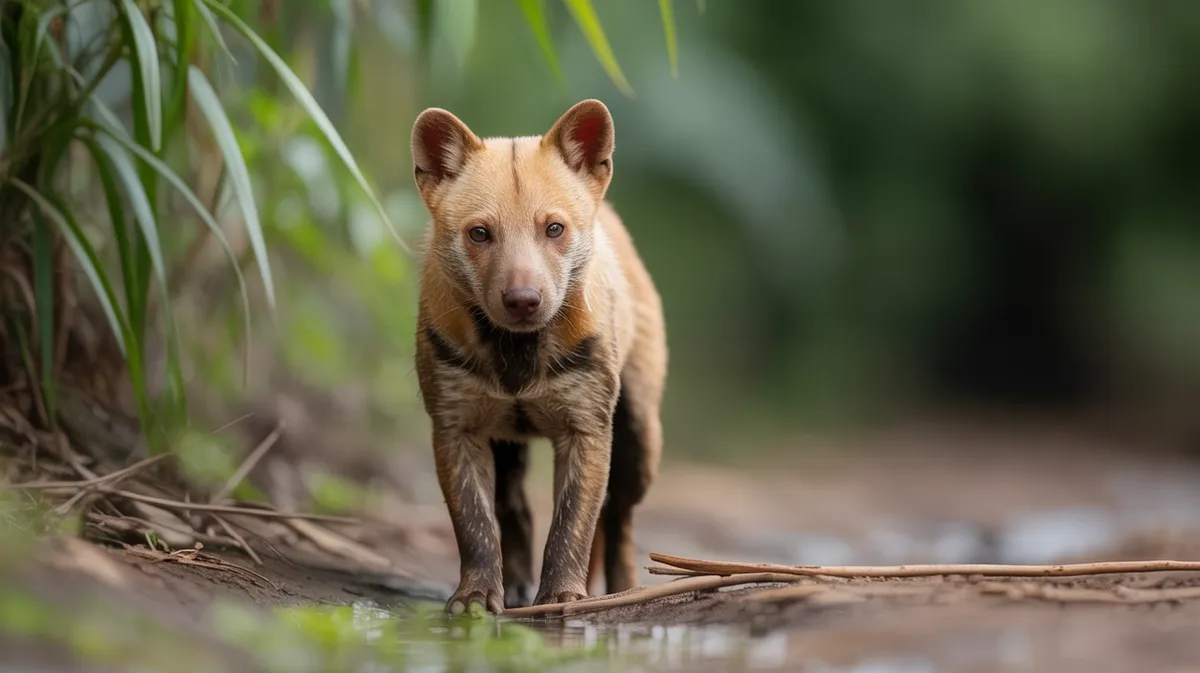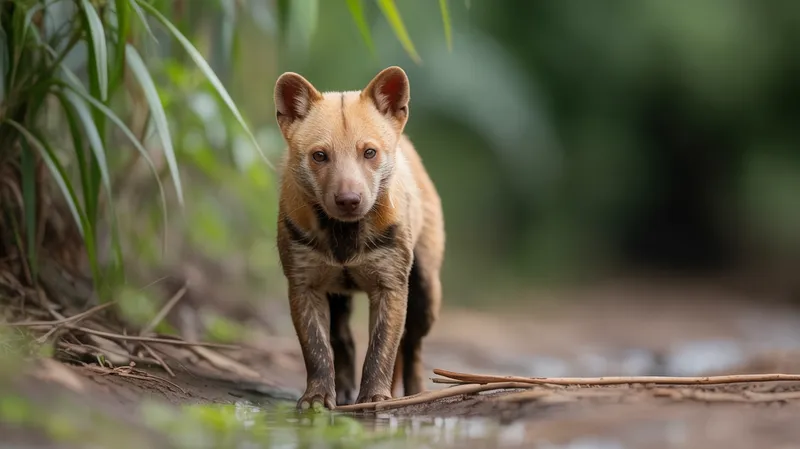
Bush Dog
Speothos venaticus

Meet the Bush Dog
The Bush Dog is a small, elusive canid native to Central and South America, known for its short legs, webbed feet, and bear-like appearance. Its dense, water-resistant fur ranges from brown to reddish, aiding its adaptation to wet habitats such as rainforests and wetlands. Bush Dogs are highly social animals, living and hunting in packs to take down prey larger than themselves, including rodents and small ungulates. Despite their wide range, they are rarely seen due to their secretive nature and preference for dense cover. Habitat loss and fragmentation pose significant threats to their populations.
Classification
Mammal
Habitat
Tropical and subtropical forests, wetlands, and grasslands near water sources
Diet
Carnivore
Lifespan
6-10 years
Conservation
Near Threatened
Weight
5-8 kg
📖Fascinating Facts
Webbed Feet
Bush Dogs have partially webbed toes, which help them swim efficiently through rivers and flooded forests.
Pack Hunters
These canids live in family groups and hunt cooperatively, often pursuing prey much larger than themselves.
Unusual Appearance
With short legs, a stocky build, and dense fur, Bush Dogs resemble small bears more than typical members of the dog family.
📋Detailed Description
The bush dog (Speothos venaticus) is a small, robust canid distinguished by its compact, elongated body, short legs, and a broad, rounded head with small, rounded ears. Adults typically measure 57–75 cm in body length, with a short tail of 12–15 cm, and weigh between 5–8 kg. Their dense, soft fur is water-resistant, ranging from dark brown to reddish-tan, with lighter underparts and a paler throat and cheeks. Bush dogs possess partially webbed toes, an adaptation that facilitates efficient swimming and movement through flooded forests and wetlands. Their dentition is specialized for a hypercarnivorous diet, with large carnassials and robust jaws. Social by nature, bush dogs live in cohesive packs of 6–12 individuals, exhibiting complex cooperative behaviors. They are crepuscular to diurnal, with peak activity in the early morning and late afternoon. Highly elusive, bush dogs communicate through a range of vocalizations, scent marking, and body language. Their range extends from Panama through much of northern and central South America, but populations are fragmented and densities are generally low outside a few strongholds.
💡 Did you know?
Despite being widespread across South America, Bush Dogs are so elusive that they were first described from fossil remains before living individuals were observed.
🔬Research & Sources
Wikipedia Summary
The bush dog is a canine found in Central and South America. In spite of its extensive range, it is very rare in most areas except in Suriname, Guyana and Peru; it was first described by Peter Wilhelm Lund from fossils in Brazilian caves and was believed to be extinct.
Last Modified: 5/17/2025
🎭Behavior & Social Structure
Bush dogs are highly social and exhibit strong pack cohesion, with coordinated group hunting and communal care of young. Packs maintain defined territories, marked with scent, and communicate using high-pitched whines, chirps, and growls. Hunting is typically cooperative, allowing them to pursue and subdue prey larger than themselves, such as agoutis, pacas, armadillos, and even small peccaries. They are adept swimmers, often hunting in or near water, and can pursue prey into aquatic environments. Feeding is communal, with dominant individuals feeding first. Bush dogs are mostly terrestrial but will climb or swim as needed. Daily routines involve periods of foraging interspersed with rest in dense cover or burrows, often dug by other animals.
👶Reproduction & Life Cycle
Bush dogs are monogamous within packs, with a dominant breeding pair producing most of the offspring. Breeding can occur year-round but may peak during the rainy season in some regions. After a gestation period of approximately 65–83 days, the female gives birth to a litter of 3–6 pups in a concealed den, often in hollow logs or abandoned burrows. All pack members participate in rearing the young, providing food and protection. Pups are born blind and helpless, opening their eyes at around two weeks and beginning to eat solid food at about one month. They are weaned by 8–10 weeks and begin accompanying adults on hunts by 4–5 months. Sexual maturity is reached at about one year of age.
🛡️Adaptations & Survival
Bush dogs display several unique adaptations for their semi-aquatic, pack-hunting lifestyle. Their webbed feet and water-repellent fur enable efficient swimming and foraging in flooded forests and wetlands. The short, sturdy limbs and elongated body facilitate movement through dense undergrowth and burrows. Their dentition is adapted for a carnivorous diet, with strong jaws capable of crushing bone. Social adaptations include complex vocal and olfactory communication, as well as cooperative hunting strategies that increase hunting success. Their cryptic coloration and secretive behavior help avoid predators and human detection.
📚Research Sources
🎨Cultural Significance
Bush dogs are rarely encountered by local people and have limited presence in indigenous folklore or traditional uses, likely due to their elusive nature and low population densities. In some regions, they are occasionally regarded as omens or curiosities, but they do not hold significant symbolic or economic importance. Their unusual appearance and social behavior have attracted interest in ecotourism and conservation education.
🔬Recent Research & Discoveries
Recent research has focused on bush dog genetics, confirming their close evolutionary relationship with the maned wolf (Chrysocyon brachyurus) and the African wild dog (Lycaon pictus) within the Caninae. Camera trap studies and environmental DNA (eDNA) surveys have improved detection in remote habitats, revealing previously unknown populations. Ongoing studies are investigating their ecological role as mesopredators, their response to habitat fragmentation, and the impact of disease transmission from domestic dogs. Conservation programs are increasingly emphasizing habitat connectivity and disease management to support population viability.
🎥Wildlife Videos

The Bush Dog Is So Rare They Thought It Was Extinct
This is the smallest and derpiest dog you've likely never heard of. Become an Animalogic member: ...
Animalogic

WILD BUSH DOG
Embark on a journey to discover the wild bush dog, an elusive carnivore native to the dense forests of South America.
The Ethical Wild

Why Bush Dogs Are So Different From Other Dogs
With the muzzle of a bear, the webbed feet of an otter and a bizarre looking tail, it's hard to believe that bush dogs are actually ...
Smithsonian Channel

The Bush Dog So Mysterious That They Thought It Was Extinct!
Welcome to the wild library channel ❂ Wild Library is a channel that follows the on goings of wildlife and nature related videos.
Wild Library

Wildlife - Just Wild Dogs | Free Documentary Nature
Wildlife - Episode 7: Just Wild Dogs | Wildlife Documentary Watch 'Wildlife - Episode 8' here: https://youtu.be/kglJpB4ei8o Run ...
Free Documentary - Nature

Wildlife - The Fascinating World of Wild Animals | Full Series | Free Documentary Nature
Wildlife - The Fascinating World of Wild Animals | Wildlife Documentary Watch 'Ocean Stories - Full Series' here: ...
Free Documentary - Nature
🌍Habitat Information
The Bush Dog typically inhabits Tropical and subtropical forests, wetlands, and grasslands near water sources environments. Bush Dogs have adapted to their environments with specialized features and behaviors.
Primary Habitat:
Tropical and subtropical forests, wetlands, and grasslands near water sources
More detailed habitat information will be available soon.
🛡️Conservation Status
The Bush Dog is currently classified as Near Threatened. Conservation efforts are crucial for preserving this species for future generations.
Common Threats:
- 🏠Habitat loss and fragmentation
- 🌡️Climate change impacts
- 🎯Hunting and poaching
- 🏭Human-wildlife conflict
⚠️Threats & Conservation Challenges
Major threats to bush dogs include habitat loss and fragmentation due to deforestation, agricultural expansion, and infrastructure development. They are also vulnerable to diseases transmitted by domestic dogs, such as canine distemper and parvovirus. Hunting pressure is generally low, but they may be persecuted in areas where they prey on poultry or small livestock. Population densities are naturally low, and the species’ secretive habits make monitoring difficult, leading to underestimation of declines. The IUCN lists the bush dog as Near Threatened, with ongoing population declines projected due to continued habitat degradation and fragmentation.
🔬Scientific Classification
Scientific Name
Speothos venaticus
Classification Hierarchy
🔍 About Taxonomic Classification
Taxonomic classification is a hierarchical system used by scientists to classify and organize living organisms based on shared characteristics and evolutionary relationships.
The system moves from broad categories (Kingdom) to increasingly specific ones, with each animal's scientific name typically consisting of its Genus and species.
📝Community Notes
Share your observations and insights about the Bush Dog with our community of wildlife enthusiasts.
Join Our Community
Sign in to share your observations and connect with fellow wildlife enthusiasts.
Sign In to ContributeNo community notes yet
Be the first to share your observations about the Bush Dog!
Explore Bush Dog
Select a tab above to learn more about this amazing animal.
📸Photo Gallery
No photos available for this animal yet.
🌟Discover More Wildlife
Continue your journey of discovery with more fascinating animals from our database
